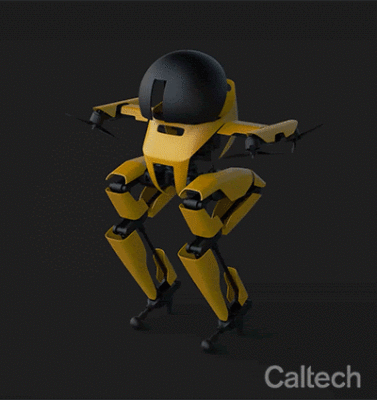In a project seeking to advance the field of robotic mobility, scientists at Caltech have unveiled a bipedal robot fitted with propellers with an unusual gate that lies between walking and flying.
The Legs Onboard Drone, or LEONARDO, made its appearance in a paper published Wednesday online in Science Robotics, and also featured on the cover of the journal’s October issue.
“Part walking robot, part flying drone, the newly developed LEONARDO — short for LEgs ONboARD drOne, or LEO for short — can walk a slackline, hop and even ride a skateboard,” Caltech said in a written statement. And the robots’ builders in Caltech’s Center for Autonomous Systems and Technologies have the video to prove it.
“LEO is the first robot that uses multi-joint legs and propeller-based thrusters to achieve a fine degree of control over its balance,” the statement added.
Caltech Professor of Aerospace and Control and Dynamical Systems and corresponding author on the paper Soon-Jo Chung said the team drew inspiration from nature.
“Think about the way birds are able to flap and hop to navigate telephone lines. A complex yet intriguing behavior happens as birds move between walking and flying. We wanted to understand and learn from that,” Chung said.
“There is a similarity between how a human wearing a jet suit controls their legs and feet when landing or taking off and how LEO uses synchronized control of distributed propeller-based thrusters and leg joints,” said Chung. “We wanted to study the interface of walking and flying from the dynamics and control standpoint.”
Adding four propellers to the 2.5-foot-tall, two-legged robot helps it overcome what has traditionally been a major challenge for bipedal machines: Rough terrain.
On the other hand, flying robots, such as drones, can easily overfly obstacles, but require large amounts of energy to do so, Caltech postdoctoral researcher and study co-lead author Kyunam Kim explained.
LEO seeks to combine the favorable aspects of both modes.
 “Robots with a multimodal locomotion ability are able to move through challenging environments more efficiently than traditional robots by appropriately switching between their available means of movement,” according to Kim. “In particular, LEO aims to bridge the gap between the two disparate domains of aerial and bipedal locomotion that are not typically intertwined in existing robotic systems.”
“Robots with a multimodal locomotion ability are able to move through challenging environments more efficiently than traditional robots by appropriately switching between their available means of movement,” according to Kim. “In particular, LEO aims to bridge the gap between the two disparate domains of aerial and bipedal locomotion that are not typically intertwined in existing robotic systems.”
The result is the ability to perform extremely complex movements with an impeccable level of balance, said study co-lead author Patrick Spieler, a former Caltech student now working at NASA’s Jet Propulsion Laboratory.
“Based on the types of obstacles it needs to traverse, LEO can choose to use either walking or flying or blend the two as needed,” he said. “In addition, LEO is capable of performing unusual locomotion maneuvers that even in humans require a mastery of balance, like walking on a slackline and skateboarding.”
The research could have implications in a wide variety of applications, from aircraft to space probes, according to Caltech.
More information on Caltech’s Center for Autonomous Systems and Technologies is available online at cast.caltech.edu.


















